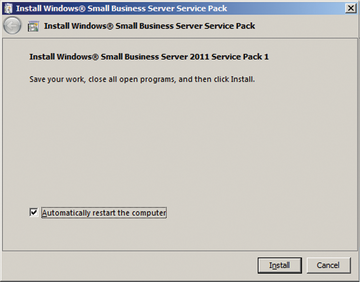« Previous 1 2 3 Next »
Making Small Business Server 2011 fit for 2014
Up-to-date
Operating System
The base operating system of SBS 2011 is Windows Server 2008 R2. If you have not already done so, first install Service Pack 1 [6] on the server. It fixes numerous vulnerabilities and other defects. This requires at least 4GB of free hard disk space, and all drivers should be up-to-date. Remove any UPS devices before installing and run a filesystem check with chkdsk c: /F. After successfully completing this test, sfc /scannow checks the important system files. To speed up the update, disable any antivirus solutions during the process.
To install the service pack, you just need to run the setup file. It detects whether you can install SP1 on Windows 7 or Windows Server 2008 R2 with SBS 2011 and takes about 30 minutes to complete.
During the installation, the computer may reboot several times; this depends on the patches already installed. If you want to prevent the automatic reboot, uncheck Automatically restart the computer (Figure 3).
 Figure 3: Service Pack 1 for Windows Server 2008 R2 hardens your Small Business Server and increases its performance.
Figure 3: Service Pack 1 for Windows Server 2008 R2 hardens your Small Business Server and increases its performance.
The success of this operation is confirmed in the SBS console below Information . After installing the service pack, the new version level is Build 7601: Service Pack 1.
Best Practices Analyzer
Once you have installed the patches and the service pack, test the basic installation of the server with the free Windows Server Solutions Best Practices Analyzer tool (WSSBPA [7]). It adheres to the rules set by the SBS developers and also detects and diagnoses hidden problems and sources of error. WSSBPA requires the Microsoft Baseline Configuration Analyzer 2.0 [8].
Additionally, the analyzer reports can be integrated into the dashboard. If this option is enabled, the tool checks the server periodically for errors and displays them. This step is recommended in virtually all cases, because it involves practically no additional load on the server. After the scan, the analyzer will present its findings, which can be sorted to suit your needs. Resolve all errors before the SBS upgrade. WSSBPA is also updated via the patch feature (Figure 4).
After you have installed all the patches, synchronize the patch database in the management console. In many cases, new updates become available after you complete the current installation. You should install Service Pack 3 for Exchange Server 2010 only after installing all the optional and mandatory updates.
The Exchange component of SBS 2011 should always be kept up to date. To do this, now install Service Pack 3 for Exchange Server 2010. After completing the download, launch the installation with setup.exe. In the wizard, you trigger the server upgrade by selecting Install Microsoft Exchange Server upgrade
. This process also restarts some services and takes down any existing client connections to the mailboxes at this point.
At the beginning of the update, the wizard checks whether all prerequisites for the update are satisfied. If it gives you the thumbs up, clicking Upgrade starts the process, which takes up to half an hour depending on system performance (Figure 5).
The status of the update is also logged in the C:\ExchangeSetupsLogs directory. The current server version can be found in the Exchange Management Console under Server Configuration
. After the upgrade and rebooting, you can see that Service Pack 3 is installed.
Exchange Update Rollup
Service Pack 3 puts the Exchange Server back on a steady footing. Update Rollup 4 then installs minor updates issued since the release of SP3. If you see an error message when installing Rollup 4, you probably have a problem with the Windows Management Framework 3. In this case, uninstall the KB2506143 update. To do this, go to Run
and type appwiz.cpl; next, select the window View installed updates
. You can then uninstall the update. If the rollup installation still does not work, it is probably a permissions issue; the instructions online [9] describe the necessary settings in detail.
Once again, you will want to stop your antivirus software for the duration of the update, because it could otherwise prevent access to the Exchange system files. Also check with the manufacturer to ensure that your protection program supports the latest server version.
The installation of these patches always follows the same pattern. You first download the current package, which is normally in msp format. Next, double-click the msp file to install the update rollup. This step can take about 20 minutes, depending on the files the package exchanges. This process also kills some Exchange services, so the server may not be available to users during the updates. After the installation, the wizard automatically restarts all services. A subsequent system restart is not required, but it does give you the assurance that all the services fire up as desired.
« Previous 1 2 3 Next »
Buy this article as PDF
(incl. VAT)
Buy ADMIN Magazine
Subscribe to our ADMIN Newsletters
Subscribe to our Linux Newsletters
Find Linux and Open Source Jobs
Most Popular
Support Our Work
ADMIN content is made possible with support from readers like you. Please consider contributing when you've found an article to be beneficial.









